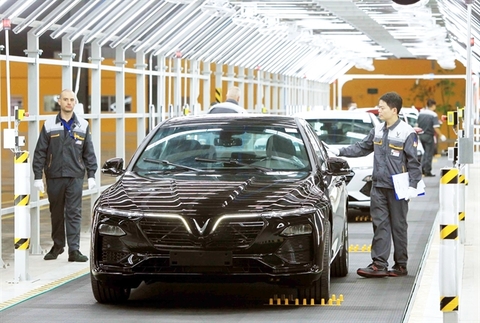Bank stocks are again back on track
Bank stocks are again back on track
Recent sessions in the stock market show that bank stocks are once again beginning to cause a stir on the floor, after a very long period of being in limbo. This is being perceived as the result of a successful effort to overcome and contain the Covid-19 pandemic across the country, accompanied by a switch in listings from UPCoM and HNX to HOSE.
Saigon-Hanoi Commercial Joint Stock Bank (SHB) approved listing from HNX to HOSE, and along with improved business results, has become the biggest gainer in recent years. Photo: Viet Chung
|
Brighter side
The stock market is entering its peak season and set to announce third quarter business results of listed companies. Listed banks are also racing to forecast business results with quite impressive figures. For example, the Tien Phong Commercial Joint Stock Bank (TPB) has pre-tax profit estimated at VND 1,000 bn, owed to growth in credit and deposits by 22.2% and 20%, respectively. TPB credit growth hit a revised ceiling issued by the State Bank of Vietnam. This growth was mainly attributed to corporate bonds and loans from bigger customers and businesses.
Similarly, the Ho Chi Minh City Development Joint Stock Commercial Bank (HDB) also recorded a strong credit growth of 12% to 13%, while over the same period in 2019, HDB achieved a profit growth of about 30%. Military Commercial Joint Stock Bank (MBB) is also expected to achieve good growth in the third quarter, due to credit growth of about 10% compared to the beginning of the year. Specifically, MBB is forecast to grow profit-before-tax in the third quarter of about 25% to 30%, equivalent to VND 3,400 bn to VND 3,600 bn. If this figure is achieved in the first nine months of 2020, MBB will have completed 98% of the year plan.
Saigon Thuong Tin Commercial Joint Stock Bank (STB) is forecast to have negative growth, as deposit and credit growth is only 7% and 9% YTD. Accordingly, pre-tax profit in the third quarter is estimated at VND 972 bn, down by 5.7%, and for nine months at VND 2,400 bn, down 3.7%. The reason for negative growth of STB was partly due to an increase in non-performing loans (NPL). According to the semi-annual financial report of 2020, at the end of the second quarter, total assets of STB increased by 6.2%, lower than in the same period last year at 8.2%. Debt ratio increased from 1.9% at the end of 2019 to 2.2%, group 2 debt increased to 2.6%, and NPL coverage was flat at about 69%. On-balance sheet bad debt on 30 June at STB amounted to VND 6,682 bn, an increase of nearly VND 950 bn compared to the beginning of the year, in which, group 3 debt increased strongly by 185% to touch VND 851 bn.
Meanwhile, the group of joint stock commercial banks with dominant state capital continued to take slow steps. For example, the Joint Stock Commercial Bank for Foreign Trade of Vietnam (VCB) showed credit growth at 6.3% and profit-before-tax in the third quarter reached VND 5,100 bn, down 18.9%. The reason was that provision expenses increased by 28.6%, Net Operating Income (TOI) decreased by 1.4%, while operating income before provisioning (PP) decreased by 6.4% to touch almost VND 7,300 bn.
Although the Joint Stock Commercial Bank for Investment and Development of Vietnam (BID) and the Vietnam Joint Stock Commercial Bank for Industry and Trade (CTG) did not record negative growth, the growth rate was still quite modest compared to that of other joint stock commercial banks. Specifically, profit-before-tax in the third quarter at BID and CTG was at VND 2,400 bn and VND 3,240 bn, respectively. This was up by 3.5% in BID and 3.8% in CTG.
Switch in listing
After a long period of trading below VND 20,000 per share, the Asia Commercial Bank (ACB) suddenly began increasing to almost VND 25,000 per share, equivalent to an increase of 25%. In addition to third quarter business results, ACB rallied from the news that the bank would switch listing from HNX to HOSE. On 16 October, HOSE announced receipt of registered documents to list more than 2.16 bn shares of ACB. Previously, ACB had approved plan to switch listing from HNX to HOSE after completing dividend payments and increasing charter capital from VND 16,627 bn to VND 21,616 bn. ACB is set to increase the market value of shares and bring benefit to shareholders with this floor change.
It is forecast that after listing on HOSE, ACB will fall into the same index basket as VN30, VNDiamond, VNFinSelect, and VNFinLead. Regarding the second quarter business results, according to Saigon Securities Inc. (SSI), ACB pre-tax profit is likely to reach a double-digit growth of about 23% to touch VND 2,370 bn. This result will be due to bank maintaining credit growth at about 9% YTD, and operating expenses (OPEX) decreasing after the bank slashed staff costs in second half of 2020.
For the same reasons, shareholders of Saigon-Hanoi Commercial Joint Stock Bank (SHB) approved plan to switch listing from HNX to HOSE in 2020. SHB was listed on HNX in 2009 and was the third bank to be listed on the stock market, after STB and ACB. However, due to flat profit, SHB could only trade below par value for a long time. From the beginning of 2020 up until now, SHB has continuously had strong breakthrough and is currently trading above VND 15,000 per share. According to analysts, there are two reasons why SHB has become the biggest gainer in recent years, one is improved business results, and second is transfer of exchange. In 2019, SHB suddenly recorded pre-tax profit increase of more than 47% to reach VND 3,077 bn. Notably, the ratio of NPL to outstanding loan also decreased to 1.83% compared to 2.4% at the beginning of 2019.
In addition to switching exchange floor, groups of banks also affirmed to their previous strong position. For example, the An Binh Commercial Joint Stock Bank (ABBank) showed nine month pre-tax profit of VND 924 bn, equity of about VND 8,348 bn, and total assets of VND 93,076 bn. NPL ratio was also controlled at 2.26% of total outstanding loans, up 0.54% compared to the end of 2019, while capital and asset efficiency ratios remaining stable.



































